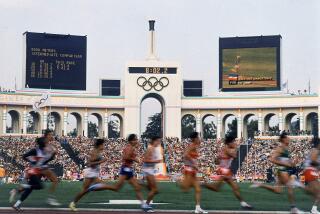Artist depicted sports in bold, colorful strokes
LeRoy Neiman, a wildly successful American artist who was famous for his colorful portraits of athletes in motion and who became an artistic fixture at such major sporting events as the Olympics and the Super Bowl, has died. He was 91.
Neiman, who was also a longtime contributor to Playboy magazine, died Wednesday in New York, said his longtime publicist, Gail Parenteau. A cause was not disclosed.
The accessible works of art he painted depicted sports and other leisure activities with bold, distinctive strokes on a canvas that invariably brimmed with color.
He was so successful that as early as 1976 The Times called him âin market terms ... a bigger success than Rembrandt -- or any other painter. He is the first sports artist of America. More significantly, Neiman is first by so far nobody knows whoâs second.â
The pronouncement was made in a three-part series on sports art that highlighted Neimanâs impressive sales figures. He had sold more than 40,000 paintings and prints -- worth an estimated $30 million in 1976 -- over the previous four years.
But his critics -- and there were many -- said Neimanâs forays into the commercial world minimized him as a serious artist. He was both loved and disdained for the same reason: His splashy conceptions of athletes in action were mass-produced.
While he focused on major American sports, such as baseball and basketball, he also gained fame in a 1972 television broadcast for sketching chess players Boris Spassky and Bobby Fischer competing against each other in Iceland.
Neimanâs âreportage of history and the passing scene ... revived an almost lost and time-honored art form,â according to a 1972 exhibit catalog of the artistâs Olympics sketches at the Indianapolis Museum of Art.
For the 1984 Summer Olympics in Los Angeles, Neiman was appointed the official artist. He was affiliated with five Olympiads.
His career received an early boost from an unlikely source: Playboy founder Hugh Hefner, who discovered the artist in 1953 when he was working as a fashion illustrator for a department store.
Neiman was soon creating art for Playboy magazine, including the well-endowed nude that has graced the magazineâs Party Jokes page since 1957.
It was the start of what he called âthe good lifeâ and inspiration for much of his future work. He regularly contributed to the magazineâs âMan at His Leisureâ feature, which took him to such places as the Grand National Steeplechase and Ascot in England and the Grand Prix auto race in Monaco.
âItâs been fun. Iâve had a lucky life,â Neiman told the Associated Press in 2008. âArt has made me pull the best out of myself.â
He was born June 8, 1921, in St. Paul, Minn., to Charles Runquist, an unskilled laborer, and his wife, Lydia. After his father abandoned the family, he took a stepfatherâs surname.
In 1942, he joined the Army and saw two years of combat during World War II. He also served as a cook.
He studied at the School of the Art Institute of Chicago, the University of Chicago and the University of Illinois.
His painting style came into being âvery suddenly,â he later said, and emerged after he experimented with discarded cans of enamel paint that allowed him to render fast-moving action with swift strokes.
After a stint in Paris, Neiman set up shop in New York and began exhibiting in galleries.
As a portraitist, he painted such iconic figures as Frank Sinatra and Babe Ruth, managing to capture how the public saw them.
He worked in many media, producing thousands of etchings, lithographs and silk screen prints. Eventually, his art gravitated toward sports.
âFor an artist, watching a [Joe] Namath throw a football or a Willie Mays hit a baseball is an experience far more overpowering than painting a beautiful woman or leading political figure,â Neiman said in 1972.
With his trademark handlebar mustache and slicked-back hair, Neiman was instantly recognizable. At a New York Jets game in 1975, fans yelled, âPut LeRoy in,â when the play wasnât going their way.
One face he repeatedly depicted was that of Muhammad Ali.
Those paintings and sketches, representing 15 years of the fighterâs life, are housed at the LeRoy Neiman Gallery at the Muhammad Ali Center in Louisville, Ky.
Neimanâs works are in the permanent collections of many private and public museums.
His philanthropy included donating $6 million to Columbia University to create the LeRoy Neiman Center for Print Studies. He also gave $3 million to the Art Institute of Chicago, where he once taught.
His studio was near Central Park in the home that he shared with Janet, his wife of 55 years. She survives him.
A workaholic who said he had no hobbies, Neiman produced large-scale works late in life, including a 160-foot-long sports mural that was hung in the Sports Museum of America, which opened in New York in 2008.
âWhat else am I good for?â he said in 2008. âI donât think about anything else.â
--
More to Read
The biggest entertainment stories
Get our big stories about Hollywood, film, television, music, arts, culture and more right in your inbox as soon as they publish.
You may occasionally receive promotional content from the Los Angeles Times.










